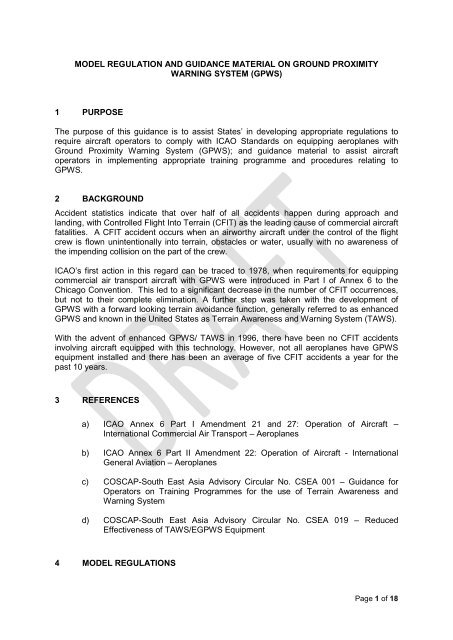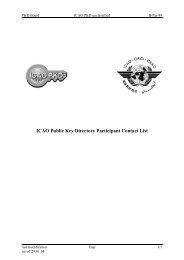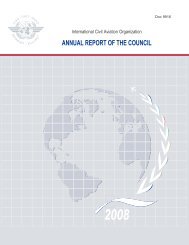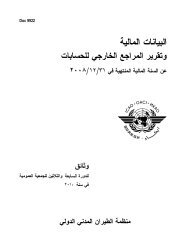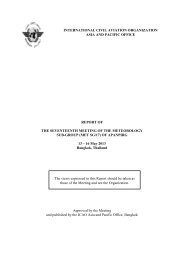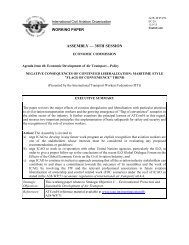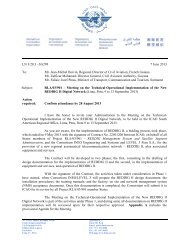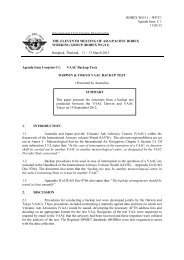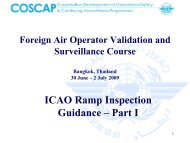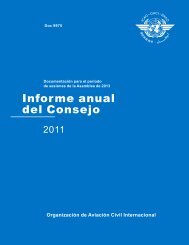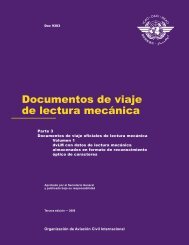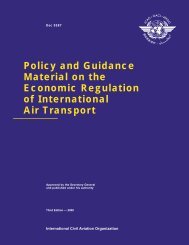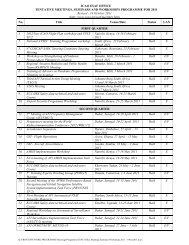GPWS - ICAO
GPWS - ICAO
GPWS - ICAO
Create successful ePaper yourself
Turn your PDF publications into a flip-book with our unique Google optimized e-Paper software.
MODEL REGULATION AND GUIDANCE MATERIAL ON GROUND PROXIMITY<br />
WARNING SYSTEM (<strong>GPWS</strong>)<br />
1 PURPOSE<br />
The purpose of this guidance is to assist States’ in developing appropriate regulations to<br />
require aircraft operators to comply with <strong>ICAO</strong> Standards on equipping aeroplanes with<br />
Ground Proximity Warning System (<strong>GPWS</strong>); and guidance material to assist aircraft<br />
operators in implementing appropriate training programme and procedures relating to<br />
<strong>GPWS</strong>.<br />
2 BACKGROUND<br />
Accident statistics indicate that over half of all accidents happen during approach and<br />
landing, with Controlled Flight Into Terrain (CFIT) as the leading cause of commercial aircraft<br />
fatalities. A CFIT accident occurs when an airworthy aircraft under the control of the flight<br />
crew is flown unintentionally into terrain, obstacles or water, usually with no awareness of<br />
the impending collision on the part of the crew.<br />
<strong>ICAO</strong>’s first action in this regard can be traced to 1978, when requirements for equipping<br />
commercial air transport aircraft with <strong>GPWS</strong> were introduced in Part I of Annex 6 to the<br />
Chicago Convention. This led to a significant decrease in the number of CFIT occurrences,<br />
but not to their complete elimination. A further step was taken with the development of<br />
<strong>GPWS</strong> with a forward looking terrain avoidance function, generally referred to as enhanced<br />
<strong>GPWS</strong> and known in the United States as Terrain Awareness and Warning System (TAWS).<br />
With the advent of enhanced <strong>GPWS</strong>/ TAWS in 1996, there have been no CFIT accidents<br />
involving aircraft equipped with this technology. However, not all aeroplanes have <strong>GPWS</strong><br />
equipment installed and there has been an average of five CFIT accidents a year for the<br />
past 10 years.<br />
3 REFERENCES<br />
a) <strong>ICAO</strong> Annex 6 Part I Amendment 21 and 27: Operation of Aircraft –<br />
International Commercial Air Transport – Aeroplanes<br />
b) <strong>ICAO</strong> Annex 6 Part II Amendment 22: Operation of Aircraft - International<br />
General Aviation – Aeroplanes<br />
c) COSCAP-South East Asia Advisory Circular No. CSEA 001 – Guidance for<br />
Operators on Training Programmes for the use of Terrain Awareness and<br />
Warning System<br />
d) COSCAP-South East Asia Advisory Circular No. CSEA 019 – Reduced<br />
Effectiveness of TAWS/E<strong>GPWS</strong> Equipment<br />
4 MODEL REGULATIONS<br />
Page 1 of 18
A model regulation as adapted from <strong>ICAO</strong> Annex 6 Part I and Part II is provided in Annex A<br />
to assist States in their development of appropriate regulation on mandating <strong>GPWS</strong><br />
equipage.<br />
5 GUIDANCE MATERIAL<br />
In addition to equipping airplanes with the necessary <strong>GPWS</strong> equipment, it is essential that<br />
operators have in place a training programme to ensure flight crew can respond effectively to<br />
<strong>GPWS</strong> warnings; are aware of factors that can reduce effectiveness of <strong>GPWS</strong> and are<br />
trained to mitigate the effects of <strong>GPWS</strong> degradation. Furthermore, operators should also<br />
have procedures in place to ensure that <strong>GPWS</strong> software/databases are current and <strong>GPWS</strong><br />
equipment remains serviceable at all times.<br />
As such, two model advisory circulars as adapted from COSCAP-South East Asia’s advisory<br />
circulars are provided in Annex B and Annex C to assist States in formulating appropriate<br />
guidance material for supporting their operators in developing the necessary training<br />
programme and procedures.<br />
6 ACTION BY STATES<br />
States may or may not have promulgated regulations to mandate the equipage of <strong>GPWS</strong><br />
equipment by aircraft operators in their State. States that have yet to do so are<br />
recommended to initiate action to mandate the equipage of <strong>GPWS</strong> equipment. In addition to<br />
complying with the <strong>ICAO</strong> standards, States are encouraged to consider adopting the <strong>ICAO</strong><br />
recommended practices as appropriate.<br />
In order for the operators to derive the greatest safety benefit from <strong>GPWS</strong> equipage, States<br />
are advised to issue guidance material to assist their operators in implementing the<br />
necessary training programme and procedures relating to <strong>GPWS</strong>.<br />
As part of the States’ inspection programme, States are recommended to conduct<br />
compliance checks on its operators to ensure all aspects of <strong>GPWS</strong> implementation are<br />
carried out satisfactorily.<br />
Page 2 of 18
Annex A<br />
Model Regulation on Ground Proximity Warning System (<strong>GPWS</strong>)<br />
1 Statutory basis<br />
1.1 This regulation is promulgated under the statutory authority in [State’s applicable civil<br />
aviation legislation/regulation(s), air navigation order(s) or regulatory standard(s)]<br />
2 Scope<br />
2.1 This regulation describes the requirements for operators to equip their aeroplanes<br />
with Ground Proximity Warning System (<strong>GPWS</strong>).<br />
2.2 This regulation establishes the minimum acceptable requirements; the operators can<br />
establish more stringent requirements.<br />
2.3 Further guidance material on this subject is contained in [State’s applicable guidance<br />
material].<br />
3 Applicability<br />
3.1 All aircraft operators shall meet the requirements set forth in this regulation.<br />
4 Effective Date<br />
4.1 This regulation is effective from [date].<br />
5 References<br />
5.1 <strong>ICAO</strong> Annex 6 Part I: Operation of Aircraft – International Commercial Air Transport –<br />
Aeroplanes<br />
5.2 <strong>ICAO</strong> Annex 6 Part II: Operation of Aircraft - International General Aviation –<br />
Aeroplanes<br />
5.3 [Applicable regulatory and/or guidance material by the State]<br />
6 Requirements for aeroplanes to be equipped with ground proximity warning<br />
system (<strong>GPWS</strong>)<br />
6.1 International Commercial Air Transport<br />
(1) No person shall operate a turbine-engined aeroplane of a maximum certificated<br />
take-off mass in excess of 5,700kg or authorised to carry more than nine<br />
passengers, unless that aeroplane is equipped with a ground proximity warning<br />
system which has a forward looking terrain avoidance function.<br />
Page 3 of 18
Annex A<br />
(2) No person shall operate a piston-engined aeroplane of a maximum certificated<br />
take-off mass in excess of 5,700kg or authorised to carry more than nine<br />
passengers, unless that aeroplane is equipped with a ground proximity warning<br />
system which provides warnings in sub-paragraphs (4)a. and (4)c., warning of<br />
unsafe terrain clearance and a forward looking terrain avoidance function.<br />
(3) A ground proximity warning system shall provide automatically a timely and<br />
distinctive warning to the flight crew when the aeroplane is in potentially<br />
hazardous proximity to the earth’s surface.<br />
(4) A ground proximity warning system shall provide, unless otherwise specified<br />
herein, warnings of the following circumstances:<br />
a. excessive descent rate<br />
b. excessive terrain closure rate<br />
c. excessive altitude loss after take-off or go-around<br />
d. unsafe terrain clearance while not in landing configuration:<br />
i. gear not locked down<br />
ii. flaps not in a landing position; and<br />
e. excessive descent below the instrument glide path<br />
6.2 International General Aviation<br />
(1) No person shall operate a turbine-engined aeroplane of a maximum certificated<br />
take-off mass in excess of 5,700kg or authorised to carry more than nine<br />
passengers, unless that aeroplane is equipped with a ground proximity warning<br />
system which has a forward looking terrain avoidance function.<br />
(2) A ground proximity warning system shall provide automatically a timely and<br />
distinctive warning to the flight crew when the aeroplane is in potentially<br />
hazardous proximity to the earth’s surface.<br />
(3) A ground proximity warning system shall provide, at a minimum, warnings of at<br />
least the following circumstances:<br />
a. excessive descent rate<br />
b. excessive altitude loss after take-off or go-around; and<br />
c. unsafe terrain clearance<br />
(4) A ground proximity warning system installed in turbine-engined aeroplanes of a<br />
maximum certificated takeoff mass in excess of 5 700 kg or authorized to carry<br />
more than nine passengers for which the individual certificate of airworthiness<br />
was first issued after 1 January 2011 shall provide, as a minimum, warnings of at<br />
least the following circumstances:<br />
a. excessive descent rate<br />
b. excessive terrain closure rate<br />
c. excessive altitude loss after take-off or go-around<br />
d. unsafe terrain clearance while not in landing configuration:<br />
i. gear not locked down<br />
ii. flaps not in a landing position; and<br />
e. excessive descent below the instrument glide path.<br />
Page 4 of 18
Annex A<br />
6.3 Operations Manual / Airplane Flight Manual<br />
The Operations Manual and/or Airplane Flight Manual shall contain instructions and<br />
training requirements, including appropriate procedures for:<br />
(1) the use of the ground proximity warning system; and<br />
(2) proper flight crew reaction in response to the ground proximity warning system<br />
audio and visual warnings.<br />
Page 5 of 18
Annex B<br />
Guidance for Operators on Training Programme on the use of Ground Proximity<br />
Warning System (<strong>GPWS</strong>)<br />
1 Purpose<br />
1.1 This advisory circular (AC) is intended to assist operators who are required to<br />
develop and conduct training progamme with regards to the use of Ground Proximity<br />
Warning System (<strong>GPWS</strong>).<br />
1.2 The information contained within has not been tailored to any specific aeroplane or<br />
<strong>GPWS</strong> equipment, but highlights features which are typically available where such<br />
systems are installed. It is the responsibility of each individual operator to determine<br />
the applicability of the contents of this AC to each aeroplane and <strong>GPWS</strong> equipment<br />
installed, and their operation. Operators should refer to their Aeroplane Flight<br />
Manual (AFM) and/or Flight Crew Operating Manual (FCOM) for information<br />
applicable to specific configurations. If there should be any conflict between the<br />
contents of this AC and those published in the other documents describe above, then<br />
information contained in the AFM or FCOM will take precedence over that contained<br />
in this AC.<br />
2 Background<br />
2.1 The introduction of ground proximity warning system (<strong>GPWS</strong>) equipment in 1978<br />
resulted in a significant reduction in controlled flight into terrain (CFIT) accidents.<br />
However, CFIT accidents do still occur, not only to those aeroplanes that have no<br />
<strong>GPWS</strong>, but also to <strong>GPWS</strong>-equipped aeroplanes that encounter terrain rising too<br />
rapidly ahead of them or that descend below a safe approach path when in a landing<br />
configuration.<br />
2.2 A further step was taken with the development of <strong>GPWS</strong> with a forward looking<br />
terrain avoidance function, generally referred to as enhanced <strong>GPWS</strong> and known in<br />
the United States as Terrain Awareness and Warning System (TAWS). With the<br />
advent of enhanced <strong>GPWS</strong>/ TAWS in 1996, there have been no CFIT accidents<br />
involving aircraft equipped with this technology. However, not all aeroplanes have<br />
<strong>GPWS</strong> equipment installed and there has been an average of five CFIT accidents a<br />
year for the past 10 years.<br />
2.2 In order to derive the greatest safety benefit from <strong>GPWS</strong> equipage, operators are<br />
required to develop the necessary training programme and procedures relating to<br />
<strong>GPWS</strong>.<br />
3 Scope<br />
3.1 This advisory circular (AC) contains performance based training objectives for<br />
Ground Proximity Warning System (<strong>GPWS</strong>) pilot training.<br />
3.2 The scope of this AC is designed to identify training objectives in the areas of:<br />
academic training; manoeuvre training; initial evaluation; and recurrent qualification.<br />
Under each of these four areas, the training material has been separated into those<br />
Page 6 of 18
Annex B<br />
items which are considered essential training items and those which are considered<br />
desirable. In each area, objectives and acceptable performance criteria are defined.<br />
3.3 No attempt is made to define how the training programme should be implemented.<br />
Instead, objectives are established that define the knowledge a pilot operating <strong>GPWS</strong><br />
is expected to possess and the performance expected from a pilot who has<br />
completed <strong>GPWS</strong> training. However, the guidelines do indicate those areas in which<br />
the pilot receiving the training should demonstrate his/her understanding, or<br />
performance, using a real-time, interactive training device, i.e. a flight simulator.<br />
Where appropriate, notes are included within the performance criteria which amplify<br />
or clarify the material addressed by the training objective.<br />
3.4 Unless otherwise stated, the term “<strong>GPWS</strong>” in this AC refers to a Ground Proximity<br />
Warning System enhanced by a forward looking terrain avoidance function.<br />
4 Applicability<br />
4.1 All operators who are required to operate aeroplanes equipped with <strong>GPWS</strong> as per<br />
[applicable regulatory requirements] should ensure the flight crew are provided with<br />
the minimum training and follow procedures as stipulated in this AC.<br />
5 Effective Date<br />
5.1 This AC is effective from [date].<br />
6 References<br />
6.1 [Applicable regulatory and/or guidance material by the State]<br />
7 Performance Based Training Objectives<br />
7.1 <strong>GPWS</strong> Academic Training<br />
This training is typically conducted in a classroom environment. The knowledge<br />
demonstrations specified in this section may be completed through the successful<br />
completion of written tests or by providing correct responses to non real-time<br />
computer based training (CBT) questions.<br />
1) Theory of operation<br />
The pilot should demonstrate an understanding of <strong>GPWS</strong> operation and the<br />
criteria used for issuing cautions and warnings. This training should address<br />
the following topics:<br />
a) System operation<br />
Objective:<br />
Criteria:<br />
To demonstrate knowledge of how <strong>GPWS</strong> functions.<br />
The pilot must demonstrate an understanding of the<br />
following functions:<br />
Page 7 of 18
Annex B<br />
(i)<br />
Surveillance<br />
• The <strong>GPWS</strong> computer processes data supplied from an air data<br />
computer, a radio altimeter, an ILS/MLS/MM (multimode) receiver,<br />
a roll attitude sensor, and flap and gear selector position sensors.<br />
• The forward looking terrain avoidance function utilises an accurate<br />
source of known aircraft position, such as may be provided by a<br />
flight management system (FMS) or global positioning system<br />
(GPS), and an electronic terrain database. The source and scope of<br />
the terrain, obstacle and airport data, and features such as the<br />
terrain clearance floor, the runway picker, and geometric altitude<br />
(where provided) should all be described.<br />
• Displays required to deliver <strong>GPWS</strong> outputs include a loudspeaker<br />
for voice announcements, visual alerts (typically amber and red<br />
lights), and a terrain awareness display (that may be combined with<br />
other displays). In addition, means must be provided for indicating<br />
the status of TAWS and any partial or total failures that may occur.<br />
(ii) Terrain Avoidance<br />
• Outputs from the <strong>GPWS</strong> computer provide visual and audio<br />
synthetic voice cautions and warnings to alert the flight crew about<br />
potential conflicts with terrain and obstacles.<br />
(b)<br />
Alert Thresholds<br />
Objective:<br />
To demonstrate knowledge of the criteria for issuing<br />
cautions and warnings.<br />
Criteria: The pilot should be able to demonstrate an<br />
understanding of the methodology used by <strong>GPWS</strong> to<br />
issue cautions and alerts and the general criteria for<br />
the issuance of these alerts to include:<br />
• Basic <strong>GPWS</strong> alerting modes specified in the <strong>ICAO</strong> Standard:<br />
Mode 1: excessive sink rate;<br />
Mode 2: excessive terrain closure rate:<br />
Mode 3: descent after take-off or go-around;<br />
Mode 4: unsafe proximity to terrain;<br />
Mode 5: descent below ILS glide slope (caution only).<br />
• An additional, optional alert mode:<br />
Mode 6: radio altitude call-out (information only).<br />
• <strong>GPWS</strong> cautions and warnings that alert the flight crew to obstacles<br />
and terrain ahead of the aircraft in line with or adjacent to its<br />
projected flight path (forward looking terrain avoidance (FLTA) and<br />
premature descent alert (PDA) functions).<br />
Page 8 of 18
Annex B<br />
(c)<br />
<strong>GPWS</strong> Limitations<br />
Objective:<br />
Criteria:<br />
To verify that the pilot is aware of the limitations of<br />
<strong>GPWS</strong>.<br />
The pilot should demonstrate a knowledge and<br />
understanding of <strong>GPWS</strong> limitations identified by the<br />
manufacturer for the equipment model installed. Items<br />
might include:<br />
• Navigation is not to be predicated on the use of the terrain display.<br />
• Unless geometric altitude data is provided, use of predictive <strong>GPWS</strong><br />
functions is prohibited when altimeter subscale settings display<br />
QFE.<br />
• Nuisance alerts can be issued if the aerodrome of intended landing<br />
is not included in the <strong>GPWS</strong> airport database.<br />
• In cold weather operations, corrective procedures should be<br />
implemented by the crew unless <strong>GPWS</strong> has in-built compensation<br />
such as geometric altitude data.<br />
• Loss of input data to the <strong>GPWS</strong> computer could result in partial or<br />
total loss of functionality. Where means exist to inform the crew that<br />
functionality has been degraded, this should be known and the<br />
consequences understood.<br />
• Radio signals not associated with the intended flight profile (eg ILS<br />
glide path transmissions from an adjacent runway) may cause false<br />
alerts.<br />
• Inaccurate or low accuracy aircraft position data could lead to false<br />
or non annunciation of terrain or obstacles ahead of the aircraft.<br />
• MEL restrictions should be applied in the event that <strong>GPWS</strong><br />
becomes partially or completely unserviceable. (It should be noted<br />
that basic <strong>GPWS</strong> has no forward-looking capability.)<br />
(d)<br />
TAWS Inhibits<br />
Objective:<br />
To verify that the pilot is aware of the conditions under<br />
which certain functions of <strong>GPWS</strong> are inhibited.<br />
Criteria: The pilot should demonstrate knowledge and<br />
understanding of the various <strong>GPWS</strong> inhibits including:<br />
• A means of silencing voice alerts;<br />
• A means of inhibiting ILS glide path signals (as may be required<br />
when executing a ILS back beam approach);<br />
Page 9 of 18
Annex B<br />
• A means of inhibiting flap position sensors (as may be required<br />
when executing an approach with the flaps not in a normal position<br />
for landing);<br />
• A means for inhibiting the FLTA and PDA functions;<br />
• A means for selecting or deselecting the display of terrain<br />
information;<br />
• Together with appropriate annunciation of the status of each<br />
selection.<br />
2) Operating Procedures<br />
The pilot should demonstrate the knowledge required to operate the <strong>GPWS</strong><br />
avionics and interpret the information presented by <strong>GPWS</strong>. This training<br />
should address the following topics:<br />
(a)<br />
Use of controls<br />
Objective:<br />
Criteria:<br />
To verify that the pilot can properly operate all <strong>GPWS</strong><br />
controls and inhibits.<br />
Demonstrate the proper use of controls including:<br />
• The means by which, before flight, any equipment self-test<br />
functions can be initiated<br />
• The means by which <strong>GPWS</strong> information can be selected for<br />
display;<br />
• The means by which all <strong>GPWS</strong> inhibits can be operated and what<br />
the consequent annunciation mean with regard to loss of<br />
functionality.<br />
(b)<br />
Display Interpretation<br />
Objective:<br />
Criteria:<br />
To verify that a pilot understands the meaning of all<br />
information that can be annunciated or displayed by<br />
<strong>GPWS</strong>.<br />
The pilot should demonstrate the ability to properly<br />
interpret information annunciated or displayed by<br />
<strong>GPWS</strong> including:<br />
• Knowledge of all visual and aural indications that may be seen or<br />
heard;<br />
• Response required on receipt of a caution;<br />
• Response required on receipt of a warning;<br />
Page 10 of 18
Annex B<br />
• Response required on receipt that partial or total failure of <strong>GPWS</strong><br />
has occurred (including annunciation that the present aircraft<br />
position is of low accuracy).<br />
(c)<br />
Use of Basic <strong>GPWS</strong> or Use of the Forward Looking Terrain Avoidance<br />
Function Only.<br />
Objective:<br />
Criteria:<br />
To verify that a pilot understands what functionality will<br />
remain following loss of the <strong>GPWS</strong> or of the forward<br />
looking terrain avoidance function.<br />
The pilot should demonstrate knowledge of the<br />
following:<br />
• How to recognise uncommanded loss of the <strong>GPWS</strong> function, or<br />
how to isolate this function, and what level of CFIT protection then<br />
remains (essentially, the forward looking terrain avoidance<br />
function).<br />
• How to recognise uncommanded loss of the forward looking terrain<br />
avoidance function, or how to isolate this function, and what level of<br />
CFIT protection then remains (essentially, basic <strong>GPWS</strong>).<br />
(d)<br />
Crew Co-ordination<br />
Objective:<br />
Criteria:<br />
To verify that the pilot adequately briefs other crew<br />
members on how <strong>GPWS</strong> alerts will be handled.<br />
The pilot should demonstrate that the pre-flight briefing<br />
addresses procedures that will be used in preparation<br />
for responding to <strong>GPWS</strong> cautions and warnings<br />
including:<br />
• What action will be taken, and by whom, in the event that a <strong>GPWS</strong><br />
caution and/or warning is issued.<br />
• How multi-function displays will be used to depict <strong>GPWS</strong> information<br />
at take-off, in the cruise, and for the descent, approach, landing (and<br />
any go-around). (This will be in accordance with procedures<br />
specified by the operator, who will recognize both that it may be<br />
more desirable that other data is displayed a t certain phases of<br />
flight, and that the terrain display has an automatic 'popup' mode in<br />
the event that an alert is issued.)<br />
(e)<br />
Reporting Requirements<br />
Objective:<br />
To verify that the pilot is aware of the requirements for<br />
reporting alerts to the controller and other authorities.<br />
Criteria: The pilot should demonstrate the following:<br />
• When, following recovery from a <strong>GPWS</strong> alert or caution, any<br />
transmission of information should be made to the appropriate air<br />
traffic control unit;<br />
Page 11 of 18
Annex B<br />
• What written report is required to be made, how it is to be made, and<br />
whether any cross- reference should be made in the aircraft<br />
technical log and/or voyage report (in accordance with procedures<br />
specified by the operator) following a flight in which the aircraft flight<br />
path has been modified in response to a <strong>GPWS</strong> alert, or if any part<br />
of the equipment appears not to have functioned correctly.<br />
(f)<br />
Alert Thresholds<br />
Objective:<br />
To demonstrate knowledge of the criteria for issuing<br />
cautions and warnings.<br />
7.2 <strong>GPWS</strong> Manoeuvre Training<br />
Criteria: The pilot should be able to demonstrate an<br />
understanding of the methodology used by <strong>GPWS</strong> to<br />
issue cautions and warnings and the general criteria for<br />
the issuance of these alerts to include:<br />
• Awareness of the modes associated with basic <strong>GPWS</strong> including the<br />
input data associated with each.<br />
• Awareness of the visual and aural annunciations that can be issued<br />
by <strong>GPWS</strong>, and how to identify which are cautions and which are<br />
warnings.<br />
The pilot should demonstrate the knowledge required to respond correctly to <strong>GPWS</strong><br />
cautions and warnings. This training should address the following topics:<br />
1) Response to Cautions<br />
Objective:<br />
Criteria:<br />
To verify that the pilot properly interprets and responds to<br />
cautions.<br />
The pilot should demonstrate that he understands the need,<br />
without delay:<br />
• To initiate action required to correct the condition that has caused <strong>GPWS</strong><br />
to issue the caution and to be prepared to respond to a warning if this<br />
should follow.<br />
• If a warning does not follow the caution, to notify the controller of the new<br />
position, heading and/or altitude/flight level of the aircraft, and what the<br />
commander intends to do next.<br />
• The proper response to a caution might require the pilot:<br />
o<br />
o<br />
o<br />
To reduce a rate of descent and/or to initiate a climb;<br />
To regain an ILS glide path from below, or to inhibit a glide path<br />
signal if an ILS is not being flown;<br />
To select more flap, or to inhibit a flap sensor if the landing is being<br />
conducted with the intent that the normal flap setting will not be<br />
used;<br />
Page 12 of 18
Annex B<br />
o<br />
o<br />
To select gear down;<br />
To initiate a turn away from the terrain or obstacle ahead and<br />
towards an area free of such obstructions if a forward looking<br />
terrain display indicates this to be a good solution and the entire<br />
manoeuvre can be carried out in clear visual conditions.<br />
2) Response to Warnings<br />
Objective:<br />
Criteria:<br />
To verify that the pilot properly interprets and responds to<br />
warnings.<br />
The pilot should demonstrate that he understands the need,<br />
without delay:<br />
• To initiate a climb in the manner specified by the operator, and<br />
• To maintain the climb until visual verification can be made that the aircraft<br />
will clear the terrain or obstacle ahead, or until above the appropriate<br />
sector safe altitude (if certain as to the location of the aircraft with respect<br />
to terrain) even if the <strong>GPWS</strong> warning stops. If, subsequently, the aircraft<br />
climbs up through the sector safe altitude but the visibility does not allow<br />
the crew to confirm that the terrain hazard has ended, checks should be<br />
made to verify the location of the aircraft and to confirm that the altimeter<br />
subscale settings are correct,<br />
• Also, and when the workload permits, the crew should notify the controller<br />
of the new position and altitude/flight level, and what the commander<br />
intends to do next.<br />
• The manner in which the climb should be made will reflect the type of<br />
aircraft and the method specified by the aircraft manufacturer (but<br />
reflected in the operations manual) for performing the escape manoeuvre.<br />
Essential aspects will include the need for an increase in pitch attitude,<br />
selection of maximum thrust, confirmation that external sources of drag<br />
(e.g. spoilers/speedbrakes) are retracted, and respect of the stick shaker<br />
or other indication of eroded stall margin.<br />
• <strong>GPWS</strong> warnings must never be ignored. However, the pilot's response<br />
may be limited to that appropriate for a caution only if the aeroplane is<br />
being operated by day in clear visual conditions, and it is immediately<br />
obvious to the pilot that the aircraft is in no danger in respect of its<br />
configuration, proximity to terrain or current flight path.<br />
7.3 <strong>GPWS</strong> Initial Evaluation<br />
1) Pilot understanding of the academic training items should be assessed by<br />
means of a written test.<br />
2) Pilot understanding of the manoeuvre training items should be assessed in a<br />
flight simulator (if available) equipped with <strong>GPWS</strong> visual and aural displays<br />
and inhibit selectors similar in appearance and operation to those in the<br />
aircraft the pilot will fly, and the results assessed by a synthetic flight<br />
instructor, synthetic flight examiner, type rating instructor or type rating<br />
examiner.<br />
Page 13 of 18
Annex B<br />
3) The range of scenarios should be designed to give confidence that proper<br />
and timely responses to <strong>GPWS</strong> cautions and warnings will result in the<br />
aircraft avoiding a CFIT accident. To achieve this objective, the pilot should<br />
demonstrate taking the correct action to prevent a caution developing into a<br />
warning and, separately, the escape manoeuvre needed in response to a<br />
warning. These demonstrations should take place when the external visibility<br />
is zero, though there is much to be learnt if, initially, the training is given in<br />
'mountainous' or 'hilly' terrain with clear visibility. This training should<br />
comprise a sequence of scenarios, rather than be included in line orientated<br />
flying training (LOFT).<br />
4) A record should be made, after the pilot has demonstrated competence, of<br />
the scenarios that were practiced.<br />
7.4 <strong>GPWS</strong> Recurrent Training (Annual)<br />
1) <strong>GPWS</strong> recurrent training ensures that pilots maintain the appropriate <strong>GPWS</strong><br />
knowledge and skills. In particular, it reminds pilots of the need to act<br />
promptly in response to cautions and warnings, and of the unusual attitude<br />
associated with flying the escape manoeuvre.<br />
2) An essential item of recurrent training is the discussion of any significant<br />
issues and operational concerns that have been identified by the operator.<br />
Recurrent training should also address changes to <strong>GPWS</strong> logic, parameters<br />
or procedures and to any unique <strong>GPWS</strong> characteristics of which pilots should<br />
be aware.<br />
8 Reporting Procedures<br />
8.1 Verbal Reports<br />
Verbal reports should be made promptly to the appropriate air traffic control unit:<br />
• Whenever any manoeuvre has caused the aircraft to deviate from an air traffic<br />
clearance;<br />
• When, subsequent to a manoeuvre that has caused the aircraft to deviate from<br />
an air traffic clearance, the aircraft has returned to a flight path that complies with<br />
the clearance;<br />
• When air traffic issue instructions that, if followed, would cause the crew to<br />
manoeuvre the aircraft towards terrain or obstacle that, it would appear from the<br />
display that a potential CFIT occurrence is likely to result.<br />
8.2 Written Reports<br />
1) Written reports should be submitted to [applicable authority] in accordance<br />
with the mandatory occurrence reporting requirements:<br />
• Whenever the aircraft flight path has been modified in response to a<br />
<strong>GPWS</strong> alert (false, nuisance or genuine).<br />
Page 14 of 18
Annex B<br />
2) Written reports should be made in the aircraft technical log:<br />
• Whenever a <strong>GPWS</strong> alert has been issued and is believed to have been false;<br />
or,<br />
• If it is believed that a TAWS alert should have been issued but was not.<br />
8.3 Within this AC, and with regards to reports:<br />
1) The term 'false' means that <strong>GPWS</strong> issued an alert that could not possibly be<br />
justified by the position of the aircraft in respect to terrain, and it is probable<br />
that a fault or failure in the system (equipment and/or input data) has been the<br />
cause.<br />
2) The term 'nuisance' means that <strong>GPWS</strong> issued an alert that was appropriate<br />
but not needed because the flight crew could determine by independent<br />
means that the flight path was at that time safe;<br />
3) The term 'genuine' means that <strong>GPWS</strong> issued an alert that was both<br />
appropriate and ' necessary.<br />
4) These terms have value in assessing, only after the occurrence is over and to<br />
facilitate subsequent analysis, the adequacy of the equipment and the<br />
programs it contains. It is not intended that flight crew should attempt to<br />
classify an alert into any of these three categories when visual and/or aural<br />
cautions or warnings are annunciated.<br />
9 Action by Operators<br />
9.1 In order to obtain the greatest safety benefit from <strong>GPWS</strong>, operators who are required<br />
to operate aeroplanes equipped with <strong>GPWS</strong> as per [applicable regulatory<br />
requirements] should ensure the flight crew are provided with the minimum training<br />
and follow procedures as stipulate in this AC.<br />
9.2 The operator is also required to maintain relevant records of all ground and simulator<br />
training provided to the flight crew for perusal by the CAA as and when required.<br />
10 Contact Person and Information<br />
10.1 Should you have any queries relating to the above, please contact [name and<br />
designation] at [contact details, e.g. email address].<br />
Page 15 of 18
Annex C<br />
Guidance for Operators to Ensure Effectiveness of <strong>GPWS</strong> Equipment<br />
1 Purpose<br />
1.1 This advisory circular (AC) provides information to operators on factors that can<br />
reduce the effectiveness of ground proximity warning system (<strong>GPWS</strong>) equipment.<br />
Several low-cost but crucial measures can be taken by stakeholders to reduce the<br />
likelihood of false <strong>GPWS</strong> warnings or, more seriously still, the system’s failure to<br />
provide a valid warning.<br />
1.2 The information contained within has not been tailored to any specific aeroplane or<br />
<strong>GPWS</strong> equipment, but highlights features which are typically available where such<br />
systems are installed. It is the responsibility of each individual operator to determine<br />
the applicability of the contents of this AC to each aeroplane and <strong>GPWS</strong> equipment<br />
installed, and their operation. Operators should refer to their Aeroplane Flight<br />
Manual (AFM) and/or Flight Crew Operating Manual (FCOM) for information<br />
applicable to specific configurations. If there should be any conflict between the<br />
contents of this AC and those published in the other documents describe above, then<br />
information contained in the AFM or FCOM will take precedence over that contained<br />
in this AC.<br />
2 Background<br />
2.1 The introduction of ground proximity warning system (<strong>GPWS</strong>) equipment in 1978<br />
resulted in a significant reduction in controlled flight into terrain (CFIT) accidents.<br />
However, CFIT accidents do still occur, not only to those aeroplanes that have no<br />
<strong>GPWS</strong>, but also to <strong>GPWS</strong>-equipped aeroplanes that encounter terrain rising too<br />
rapidly ahead of them or that descend below a safe approach path when in a landing<br />
configuration.<br />
2.2 A further step was taken with the development of <strong>GPWS</strong> with a forward looking<br />
terrain avoidance function, generally referred to as enhanced <strong>GPWS</strong> and known in<br />
the United States as Terrain Awareness and Warning System (TAWS). With the<br />
advent of enhanced <strong>GPWS</strong>/ TAWS in 1996, there have been no CFIT accidents<br />
involving aircraft equipped with this technology. However, not all aeroplanes have<br />
<strong>GPWS</strong> equipment installed and there has been an average of five CFIT accidents a<br />
year for the past 10 years.<br />
2.3 In order to derive the greatest safety benefit from <strong>GPWS</strong> equipage, operators are<br />
encouraged to adopt necessary measures and practices as stipulated in this AC.<br />
3 Scope<br />
3.1 This advisory circular (AC) contains measures that will ensure the effectiveness of<br />
<strong>GPWS</strong> equipment.<br />
3.2 This AC is designed to lower the risk of CFIT accidents by reducing the possibility<br />
that no warning will be given when a prompt warning is required; as well as reducing<br />
the possibility of navigation and position shift errors and the occurrence of false<br />
warnings.<br />
Page 16 of 18
Annex C<br />
3.3 Unless otherwise stated, the term “<strong>GPWS</strong>” in this AC refers to a Ground Proximity<br />
Warning System enhanced by a forward looking terrain avoidance function.<br />
4 Applicability<br />
4.1 All operators who are required to operate aeroplanes equipped with <strong>GPWS</strong> as per<br />
[applicable regulatory requirements] must establish procedures to ensure that the<br />
effectiveness of installed <strong>GPWS</strong> equipment is maintained to the required<br />
specifications.<br />
5 Effective Date<br />
5.1 This AC is effective from [date].<br />
6 References<br />
6.1 [Applicable regulatory and/or guidance material by the State]<br />
7 Software Update<br />
7.1 Perhaps the most easily rectified shortcoming involves the software utilized by<br />
<strong>GPWS</strong>. Software updates are issued regularly, yet industry sources reveal these are<br />
not being implemented by all operators, or are not installed in a timely manner. Aside<br />
from the fact updates are often available free of charge from equipment<br />
manufacturers, there is ample reason to perform this task since the use of current<br />
information is clearly critical to safety.<br />
7.2 Application of software updates improves the characteristics of the equipment. Such<br />
improvements are possible on the basis of operational experience, and enable<br />
warnings in situations that occur closer to the runway threshold where previously it<br />
was not possible to provide such warnings.<br />
7.3 Without information provided by the latest version of software, operation of <strong>GPWS</strong><br />
may be compromised in specific situations. The flight crew, who has no convenient<br />
means of knowing the software status of the equipment on which they ultimately rely,<br />
may have a false sense of confidence in its capability.<br />
8 Database Update<br />
8.1 Similarly, it is crucial to regularly update the obstacle, runway and terrain database<br />
provided by manufacturers for use with their equipment, since the proper functioning<br />
of the <strong>GPWS</strong> may otherwise be jeopardized. Again, updates are issued for these<br />
databases on a regular basis, free of charge by equipment manufacturers. <strong>GPWS</strong><br />
operation can also be undermined by the lack of suitable navigational input. The<br />
equipment was designed to function with a position update system, but not all<br />
installations are linked to GNSS receivers. While the required position data can be<br />
acquired by using an effective ground-based navaid network, the most reliable of<br />
which is provided by DME/DME, such support for area navigation systems is not<br />
available everywhere. Use of GNSS, accessible worldwide, eliminates the possibility<br />
Page 17 of 18
Annex C<br />
of position shift, which is another source of false warnings (or worse, the failure to<br />
provide a genuine warning).<br />
8.2 Collectively, these various shortcomings in the software, databases and procedures<br />
that support <strong>GPWS</strong> operation can degrade the value of the warning system, and<br />
clearly call for attention by national regulatory authorities, aircraft operators and<br />
manufacturers. To reduce the risk of CFIT as much as possible, countries around the<br />
world need to ensure that timely information of required quality on runway thresholds,<br />
as well as terrain and obstacle data, are provided for databases in accordance with<br />
the common reference systems.<br />
9 Altimetry Based Errors<br />
9.1 Operation of <strong>GPWS</strong> is subject to altimetry-based errors, which are more prominent<br />
during cold weather operations. This problem can be avoided when the equipment,<br />
originally designed to work with the QNH altimeter setting, is operated together with<br />
GNSS provided geometric altitude. Additionally, use of the geometric altitude function<br />
prevents errors that arise from the use of the QFE altimeter setting for approach and<br />
landing.<br />
10 Action by Operators<br />
10.1 In order to obtain the greatest safety benefit from <strong>GPWS</strong>, operators who are required<br />
to operate aeroplanes equipped with <strong>GPWS</strong> as per [applicable regulatory<br />
requirements] must establish certain practices directly related to the equipment in<br />
use. This includes:<br />
1) Update software to the latest available standard;<br />
2) Update databases to the latest available standard;<br />
3) Ensure that the GNSS position is provided to <strong>GPWS</strong>;<br />
4) Enable the <strong>GPWS</strong> geometric altitude function (if available);<br />
5) Enable the <strong>GPWS</strong> peaks and obstacles function (if available); and<br />
6) Implement any applicable service bulletins issued by manufacturers.<br />
10.2 It is essential that other measures be undertaken to ensure CFIT prevention through<br />
effective use of <strong>GPWS</strong>. These measures include, but are not limited to: crew training;<br />
use of standard operating procedures; crew reporting and operator investigation of<br />
spurious warnings; and implementation of a safety management system by the<br />
operator.<br />
11 Contact Person and Information<br />
11.1 Should you have any queries relating to the above, please contact [name and<br />
designation] at [contact details, e.g. email address].<br />
Page 18 of 18


